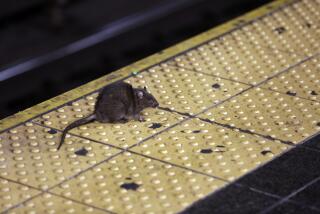Prehistoric Rat Aids Modern Study : Science: The preserved nests of 38,000-year-old rodents have been found in Nevada. Scientists are using them for insight into environmental evolution.
RENO — While early man was supplanting the Neanderthals in Europe and the Ice Age still held Earth in its grip, a furry little rat was scurrying about the Nevada desert, gathering leaves and other debris.
That was 38,000 years ago. The Neanderthals left behind their bones and some artifacts. The glaciers scoured the continents. The rat left its nest.
Thanks to Nevada’s dust-dry climate, the pack rat’s nest remained relatively intact and wonderfully preserved, providing an emerging branch of science a new insight into environmental evolution.
Peter Wigand, a paleoecologist at the Desert Research Institute, spends a lot of time hunting for pack rat nests. The nests--or middens--tell him what the area’s ecology was like and what may be in store for the future.
“Pack rat nests are like snapshots on the landscape,” Wigand said. Used with other research methods, they can provide a more detailed look at environmental history.
The pack rat, also called a wood rat, is a constant gatherer, Wigand explained. “He collects a little bit of everything. They drag almost anything in.”
Eventually, the nest becomes overburdened with junk and a new one is built. The old homestead then becomes the outhouse.
Because the rats rarely drink water and get most of their moisture by eating plants, their viscous urine acts as a sealant. The nest, along with its collectibles, is virtually preserved intact.
Since the rats feed close to their homes, Wigand said scientists can mark the elevation at which the midden is located to determine what the climate was like based on the types of vegetation contained in the nest.
Successive generations sometimes will build middens near those already abandoned by predecessors. Such pat rack condos can span thousands of years, giving scientists a unique textbook on the abundance and disappearance of vegetation and water over time in a particular area.
At the laboratory the midden is soaked, then strained through sieves. Scientists using tweezers pick through the material under a microscope, separating juniper berries, pine needles, bones and insects.
Arrowheads, ancient twine, other animal feces, tick heads, even fish scales have been found.
“It tells us about the Earth’s past environment . . . so that we can predict how its environment may react to future climate change,” Wigand said.
One place where predicting future climatic conditions has become critical is Yucca Mountain in southern Nevada. The federal government wants to build the nation’s first high-level nuclear waste dump there.
Located 100 miles northwest of Las Vegas, Yucca Mountain on the Nevada Test Site would be used to store up to 77,000 tons of highly radioactive waste for 10,000 years.
Wigand is among a group of researchers studying water movement at the site.
Middens gathered from the area also date back 38,000 years, he said, and indicate that until 12,000 years ago the hot expanse of desert was relatively cooler and wetter than it is today.
Rat nest samples have shown that the area, which currently receives about 8 inches of annual rainfall, received at least two to three times that much in the past, Wigand said.
“It poses the possibility that if we have such a climate change in the future, there is a potential for radioactive materials to be carried into the ground water table,” he said.
Scientists are concerned that if heavy precipitation ever returns to the desert, runoff could leach through the mountain, corrode storage canisters and contaminate the ground water.
Wigand and other researchers are working with the U.S. Geological Survey to refine estimates on the effects different amounts of rainfall would have on the terrain.
The current eight-year drought, he said, is exceptionally short when compared with the 40-to-60-year dry spells that have occurred over the last 700 years.






